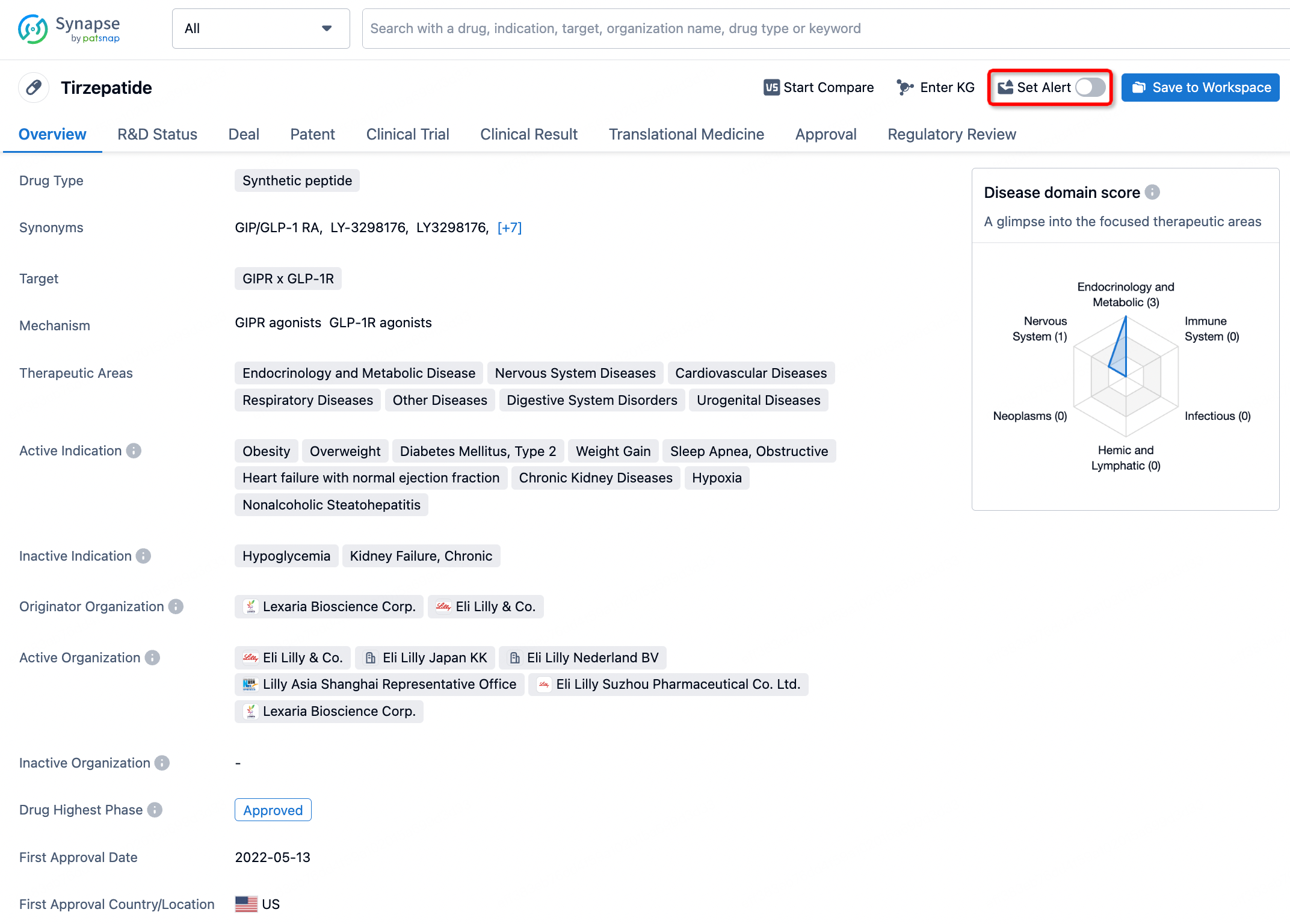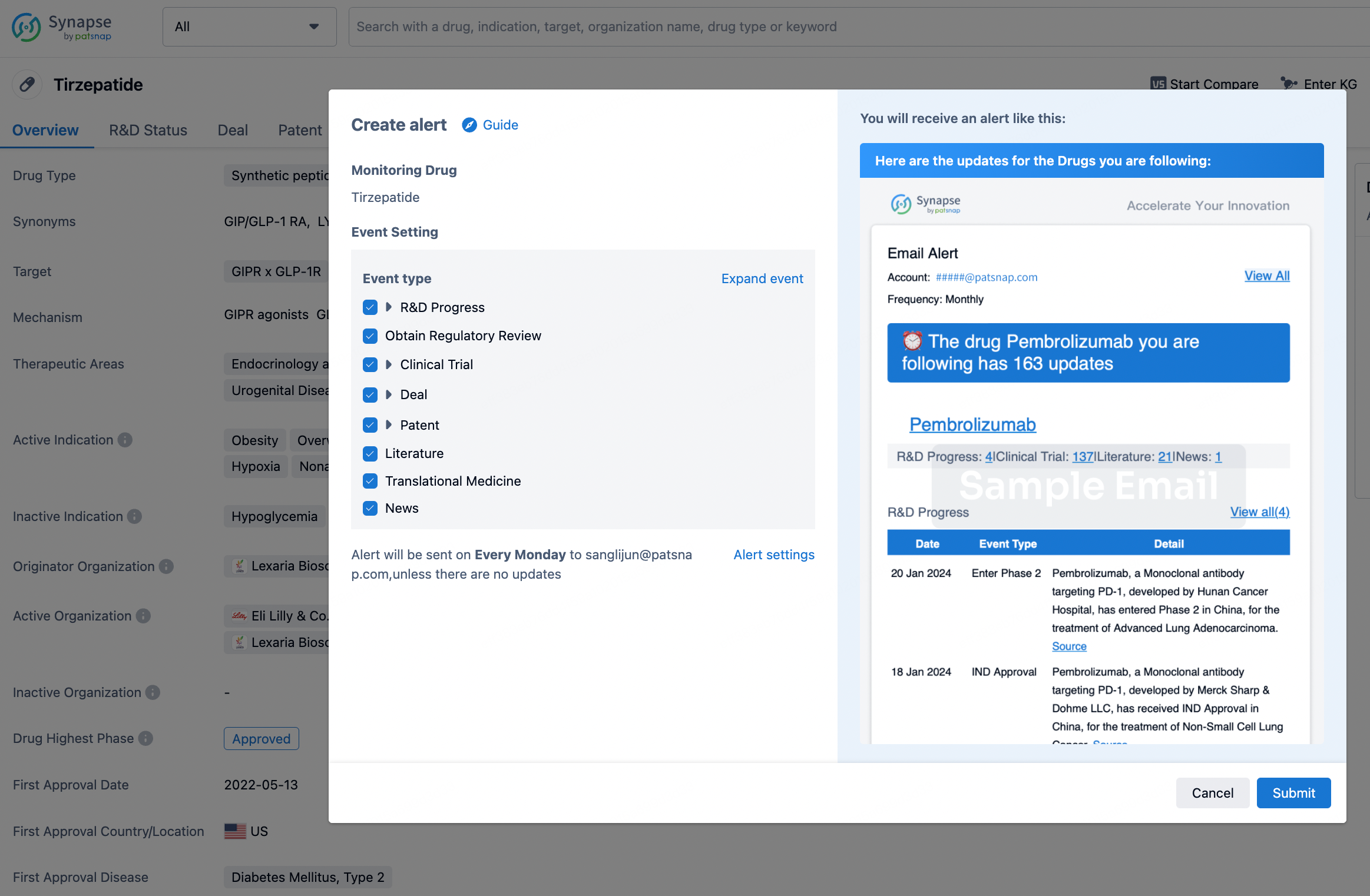Request Demo
What is Hexobarbital used for?
15 June 2024
Hexobarbital: An In-Depth Exploration
Hexobarbital is a barbiturate derivative that has been widely studied and utilized for its sedative and hypnotic properties. Known by various trade names such as Evipan and Citopan, it has found its place in both clinical settings and research laboratories. Hexobarbital acts on the central nervous system, primarily targeting the GABA-A receptors, which play a critical role in inhibitory neurotransmission. This drug has been historically prescribed for its efficacy in inducing anesthesia and managing seizures, though its use has diminished with the advent of newer, safer alternatives.
Several research institutions have delved into the study of Hexobarbital to understand its pharmacodynamics, pharmacokinetics, and potential therapeutic applications. Some of these renowned institutions include the National Institutes of Health (NIH), the Mayo Clinic, and various university-based research centers. Although Hexobarbital is no longer a frontline treatment due to its potential side effects and the development of more modern medications, it remains a subject of significant scientific interest. Researchers continue to explore its mechanisms of action, potential off-label uses, and the implications of its long-term use.
Hexobarbital Mechanism of Action
The primary mechanism of action of Hexobarbital involves its interaction with the GABA-A receptors in the brain. GABA (gamma-aminobutyric acid) is the primary inhibitory neurotransmitter in the central nervous system, and its activation leads to a decrease in neuronal excitability. Hexobarbital enhances the effect of GABA by binding to a specific site on the GABA-A receptor complex. This binding increases the duration of chloride channel opening, leading to hyperpolarization of the neuronal membrane and, consequently, a decrease in neuronal firing.
This action results in the sedative, hypnotic, and anticonvulsant properties of Hexobarbital. Additionally, Hexobarbital can inhibit the excitatory neurotransmitter glutamate by acting on the AMPA receptors. This dual mechanism further contributes to its effectiveness in reducing neuronal excitability and inducing anesthesia. However, it is this potent effect on the central nervous system that also accounts for the potential side effects and risks associated with its use.
How to Use Hexobarbital
Hexobarbital can be administered through various routes, including intravenous (IV), intramuscular (IM), and oral forms. The choice of administration depends on the required onset time and clinical context. For rapid induction of anesthesia, the IV route is preferred due to its quick onset of action, typically within 30 seconds to a few minutes. This makes it suitable for procedures requiring rapid sedation.
For less immediate needs, such as managing seizure activity or providing moderate sedation, the IM route can be used. The onset of action via this method is slower compared to IV administration, generally taking 10 to 30 minutes. Oral administration is less common due to its variable absorption and slower onset of action, which can range from 30 minutes to an hour.
The dosage of Hexobarbital must be carefully calculated based on the patient's age, weight, and medical condition. Overdosage can lead to severe respiratory depression, coma, and even death. Therefore, it is crucial that Hexobarbital is administered under strict medical supervision, with close monitoring of the patient's respiratory and cardiovascular status.
What are Hexobarbital Side Effects
While Hexobarbital is effective in its intended uses, it also carries a range of potential side effects. Common side effects include drowsiness, dizziness, lethargy, and ataxia. These effects are generally dose-dependent and can be more pronounced with higher doses. Gastrointestinal disturbances such as nausea and vomiting may also occur.
More serious side effects include respiratory depression, hypotension, and bradycardia. These effects are particularly concerning in patients with preexisting respiratory or cardiovascular conditions. Chronic use of Hexobarbital can lead to tolerance, dependence, and withdrawal symptoms. Withdrawal from Hexobarbital should be managed carefully, often requiring a gradual tapering of the dose to mitigate withdrawal effects such as seizures, agitation, and delirium.
Hexobarbital is contraindicated in patients with a known hypersensitivity to barbiturates, severe respiratory insufficiency, and porphyria—a group of disorders resulting from a buildup of natural chemicals that produce porphyrin in your body. Additionally, caution is advised when using Hexobarbital in elderly patients, those with liver or kidney impairment, and patients with a history of substance abuse. The use of Hexobarbital in pregnant or breastfeeding women is also generally discouraged due to potential risks to the fetus or infant.
What Other Drugs Will Affect Hexobarbital
Hexobarbital can interact with a variety of other medications, leading to altered effects and increased risks of side effects. One of the most significant interactions is with other central nervous system depressants, including alcohol, benzodiazepines, opioids, and other barbiturates. Concurrent use of these substances can lead to enhanced sedative effects, severe respiratory depression, and increased risk of overdose.
Enzyme-inducing drugs such as rifampin, phenytoin, and carbamazepine can accelerate the metabolism of Hexobarbital, potentially reducing its efficacy. Conversely, drugs that inhibit liver enzymes, like cimetidine and certain antifungal medications, can increase Hexobarbital levels in the blood, heightening the risk of toxicity.
Certain medications may also be impacted by Hexobarbital. For instance, Hexobarbital can reduce the effectiveness of oral contraceptives and anticoagulants like warfarin by increasing their metabolism. This necessitates careful monitoring and possible dose adjustments of the affected medications.
In conclusion, while Hexobarbital has largely been supplanted by newer drugs with better safety profiles, it remains a valuable tool in specific medical and research contexts. Its potent effects on the central nervous system make it effective for inducing anesthesia and managing seizures, yet these same effects also necessitate careful administration and monitoring to avoid serious side effects and drug interactions. Continued research into Hexobarbital's mechanisms and potential uses may yet reveal new applications for this historically significant drug.
Hexobarbital is a barbiturate derivative that has been widely studied and utilized for its sedative and hypnotic properties. Known by various trade names such as Evipan and Citopan, it has found its place in both clinical settings and research laboratories. Hexobarbital acts on the central nervous system, primarily targeting the GABA-A receptors, which play a critical role in inhibitory neurotransmission. This drug has been historically prescribed for its efficacy in inducing anesthesia and managing seizures, though its use has diminished with the advent of newer, safer alternatives.
Several research institutions have delved into the study of Hexobarbital to understand its pharmacodynamics, pharmacokinetics, and potential therapeutic applications. Some of these renowned institutions include the National Institutes of Health (NIH), the Mayo Clinic, and various university-based research centers. Although Hexobarbital is no longer a frontline treatment due to its potential side effects and the development of more modern medications, it remains a subject of significant scientific interest. Researchers continue to explore its mechanisms of action, potential off-label uses, and the implications of its long-term use.
Hexobarbital Mechanism of Action
The primary mechanism of action of Hexobarbital involves its interaction with the GABA-A receptors in the brain. GABA (gamma-aminobutyric acid) is the primary inhibitory neurotransmitter in the central nervous system, and its activation leads to a decrease in neuronal excitability. Hexobarbital enhances the effect of GABA by binding to a specific site on the GABA-A receptor complex. This binding increases the duration of chloride channel opening, leading to hyperpolarization of the neuronal membrane and, consequently, a decrease in neuronal firing.
This action results in the sedative, hypnotic, and anticonvulsant properties of Hexobarbital. Additionally, Hexobarbital can inhibit the excitatory neurotransmitter glutamate by acting on the AMPA receptors. This dual mechanism further contributes to its effectiveness in reducing neuronal excitability and inducing anesthesia. However, it is this potent effect on the central nervous system that also accounts for the potential side effects and risks associated with its use.
How to Use Hexobarbital
Hexobarbital can be administered through various routes, including intravenous (IV), intramuscular (IM), and oral forms. The choice of administration depends on the required onset time and clinical context. For rapid induction of anesthesia, the IV route is preferred due to its quick onset of action, typically within 30 seconds to a few minutes. This makes it suitable for procedures requiring rapid sedation.
For less immediate needs, such as managing seizure activity or providing moderate sedation, the IM route can be used. The onset of action via this method is slower compared to IV administration, generally taking 10 to 30 minutes. Oral administration is less common due to its variable absorption and slower onset of action, which can range from 30 minutes to an hour.
The dosage of Hexobarbital must be carefully calculated based on the patient's age, weight, and medical condition. Overdosage can lead to severe respiratory depression, coma, and even death. Therefore, it is crucial that Hexobarbital is administered under strict medical supervision, with close monitoring of the patient's respiratory and cardiovascular status.
What are Hexobarbital Side Effects
While Hexobarbital is effective in its intended uses, it also carries a range of potential side effects. Common side effects include drowsiness, dizziness, lethargy, and ataxia. These effects are generally dose-dependent and can be more pronounced with higher doses. Gastrointestinal disturbances such as nausea and vomiting may also occur.
More serious side effects include respiratory depression, hypotension, and bradycardia. These effects are particularly concerning in patients with preexisting respiratory or cardiovascular conditions. Chronic use of Hexobarbital can lead to tolerance, dependence, and withdrawal symptoms. Withdrawal from Hexobarbital should be managed carefully, often requiring a gradual tapering of the dose to mitigate withdrawal effects such as seizures, agitation, and delirium.
Hexobarbital is contraindicated in patients with a known hypersensitivity to barbiturates, severe respiratory insufficiency, and porphyria—a group of disorders resulting from a buildup of natural chemicals that produce porphyrin in your body. Additionally, caution is advised when using Hexobarbital in elderly patients, those with liver or kidney impairment, and patients with a history of substance abuse. The use of Hexobarbital in pregnant or breastfeeding women is also generally discouraged due to potential risks to the fetus or infant.
What Other Drugs Will Affect Hexobarbital
Hexobarbital can interact with a variety of other medications, leading to altered effects and increased risks of side effects. One of the most significant interactions is with other central nervous system depressants, including alcohol, benzodiazepines, opioids, and other barbiturates. Concurrent use of these substances can lead to enhanced sedative effects, severe respiratory depression, and increased risk of overdose.
Enzyme-inducing drugs such as rifampin, phenytoin, and carbamazepine can accelerate the metabolism of Hexobarbital, potentially reducing its efficacy. Conversely, drugs that inhibit liver enzymes, like cimetidine and certain antifungal medications, can increase Hexobarbital levels in the blood, heightening the risk of toxicity.
Certain medications may also be impacted by Hexobarbital. For instance, Hexobarbital can reduce the effectiveness of oral contraceptives and anticoagulants like warfarin by increasing their metabolism. This necessitates careful monitoring and possible dose adjustments of the affected medications.
In conclusion, while Hexobarbital has largely been supplanted by newer drugs with better safety profiles, it remains a valuable tool in specific medical and research contexts. Its potent effects on the central nervous system make it effective for inducing anesthesia and managing seizures, yet these same effects also necessitate careful administration and monitoring to avoid serious side effects and drug interactions. Continued research into Hexobarbital's mechanisms and potential uses may yet reveal new applications for this historically significant drug.
How to obtain the latest development progress of all drugs?
In the Synapse database, you can stay updated on the latest research and development advances of all drugs. This service is accessible anytime and anywhere, with updates available daily or weekly. Use the "Set Alert" function to stay informed. Click on the image below to embark on a brand new journey of drug discovery!
AI Agents Built for Biopharma Breakthroughs
Accelerate discovery. Empower decisions. Transform outcomes.
Get started for free today!
Accelerate Strategic R&D decision making with Synapse, PatSnap’s AI-powered Connected Innovation Intelligence Platform Built for Life Sciences Professionals.
Start your data trial now!
Synapse data is also accessible to external entities via APIs or data packages. Empower better decisions with the latest in pharmaceutical intelligence.


